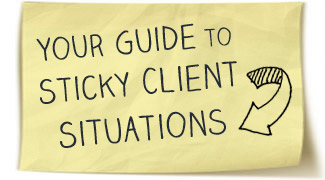
It seems like a perfectly normal thing to do. Everywhere you turn, you see ads on TV offering a one month free trial at the gym. Fifty percent off appetizers during happy hour. Buy one pair of shoes, get 20 percent off the second.
But for small businesses or freelancers, these giveaways can be deadly.
Too often, cash-strapped self-employed women take on new clients at a discount, only to find themselves frustrated and equally cash-strapped when that client sticks around, requires a lot of extra time on email and the phone as they try to get “the most” for their money, and generally makes the freelancer miserable.
In the long run, discounting will not make you happy with your clients, and that will cause your work to suffer.
Nip these poorly-paid projects in the bud with these three steps.
Let the Client Start the Negotiation
It happens to all of us. You have a conversation with a client that is going great. Then, they ask the dreaded question:
What’s your rate for this?
Eager to please the client you have such a great rapport with, you blurt out a number you earned on a similar project in the past, without taking into account all the work associated with the project, and with a little discount because you feel like you have such a great thing going with the client.
WRONG!!. On so many levels, but to start: NEVER give project estimates on the phone.
Your emotions get in the way. And you don’t have the time and space to accurately consider the work involved and how that work fits into your schedule.
Pricing is a game of chicken, and you never want to drop a number first unless you absolutely have no choice. When a client asks your rate, tell them you need time to put together an accurate estimate and ask what their budget is.
If they refuse to say, the prospect probably doesn’t know what their budget is, is shopping around, and is looking for the lowest price they can get. Also known as: they can’t really afford you and will be painful to work with.
When I have seen women submit numbers in the dark like this, it’s pretty much universally resulted in a frightened no/we can’t afford that, so it’s worth telling the prospect you can’t put together a proposal without a number.
Try this:
You: What’s your budget for this project?
Prospect: I don’t know/don’t want to tell you/send me some numbers and we’ll go from there.
You: Actually, I make rather detailed proposals with options at a variety of price points, so I really need to know the range of your budget to do that. If you truly don’t feel comfortable/ready to give me a number, why don’t you let me know once you’ve done more research and are more ready to move forward with this project so I can make an accurate proposal. Thanks!
Start With Smart Price Setting, High Price Setting
The key to being happy with your prices—even when you feel justified in discounting them—is to understand the value you are providing and make sure the client does as well.
I recently I overheard a conversation about a sticky client situation that I unfortunately hear all too often: a freelance web designer was tired of giving away hours and hours of free work because she took on clients at a discount.
Because she specialized in websites for non-profits, with the occasional start-up thrown in, she was positioned to automatically get inbound clients looking for the lowest rate possible.
Sometimes you really want to take on a client who can’t quite afford you, but that doesn’t mean that you and the client should both suffer because of it. Take a hard look at what they’re asking you to do and how many hours you think it will take you. Then, use this formula to get an initial number:
Estimated hours involved
x PITA factor (how annoying the client seems/how likely to make things take longer than you expect. Multiply by a number between 1 for average sounding hands-off client to 2 or 2.5 for a real micromanager) x
x Accuracy cushion (have you done a project like this before and documented your hours so you are highly confident in your time estimate? Multiple by 1. If you need new skills or to do lots of additional research, multiply by 2-3)
x Your hourly rate
= PROJECT ESTIMATE
The client doesn’t need to know if your actual work hours come in under what you estimate. Think of it as a new client security fee.
Does that seem unfair? Like you’ve charged this client an extra pain-in-the-ass fee that wasn’t necessary? Don’t feel bad! They agreed to this price and found it to be a fair exchange for the value you provided them.
Offer the Client Ways to Save Money That Save You Time
A new freelancer and soon to be mom came to me with a conundrum a few weeks back…..
She really loved the exposure work for a certain client gets her, but she finds herself spending two weeks on a video project that pays $500 max.
We all want to do our best work, but at the same time, we have to be mindful of the time that work takes. If you like your client, and they like you, can you negotiate a way to do less work so you stay within their monetary budget while keeping to the amount of time you budget for that amount of income?
Try this:
I know that you told me your budget for this project is $X, but I’ve run the numbers a few times, and I simply could not do all the work you’re asking for for under $X.
I’m really excited about this project and found a way that we can still work together. Would you be able to remove ____, ____, or ____ aspects of the project, either by taking them in house or outsourcing them separately?
That way, I could complete the proposed project at top quality within your budget.
Look forward to the opportunity to work with you!
Here are so more ways to respond if someone is asking for a discount.





